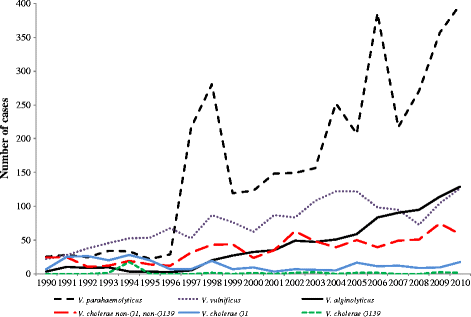Antibiotic use for Vibrio infections: important insights from surveillance data
- PMID: 26062903
- PMCID: PMC4464855
- DOI: 10.1186/s12879-015-0959-z
Antibiotic use for Vibrio infections: important insights from surveillance data
Abstract
Background: There is a paucity of data on the in vivo efficacy of antibiotics for lethal Vibrio species. Analyses of long-term surveillance datasets may provide insights into use of antibiotics to decrease mortality.
Methods: The United States Centers for Disease Control and Prevention (CDC) Cholera and Other Vibrio Illness Surveillance (COVIS) dataset from 1990 to 2010, with 8056 records, was analysed to ascertain trends in antibiotics use and mortality.
Results: Two-thirds of patients (5243) were prescribed antibiotics - quinolones (56.1 %), cephalosporins (24.1 %), tetracyclines (23.5 %), and penicillins (15.4 %). Considering all Vibrio species, the only class of antibiotic associated with reduced odds of mortality was quinolone (odds ratio 0.56, 95 % CI 0.46-0.67). Patients with V. vulnificus treated according to CDC recommendations had lower mortality (quinolone alone: 16.7 %, 95 % CI 10.2-26.1; tetracycline plus cephalosporin: 21.7 %, 16.8-27.5; no antibiotic: 51.1 %, 45.6-56.7; each p < 0.001). Cephalosporin alone was associated with higher mortality (36.8 %, 28.2-46.3). For V. cholerae non-O1, non-O139, mortality rates were lower for quinolone (0 %, 0-2.0) or tetracycline (4.3 %, 1.2-14.5) compared to no antibiotic (9.3 %, 6.4-13.3). For all Vibrio species, mortality rates increased with number of antibiotics in the treatment regimen (p < 0.001). Treatment regimens that included quinolone were associated with lower mortality rates regardless of the number of antibiotics used. The main clinical syndromes of patients with V. vulnificus infection were septicaemia (53.1 %) and wound infections (30.6 %). Mortality among V. vulnificus patients with septicaemia was significantly higher than for other clinical syndromes (p < 0.001). In a multivariate regression model, mortality in cases with V. vulnificus was associated with presence of pre-existing conditions (ORs ranged from 4.52 to 10.30), septicaemia (OR 2.64, 95 % CI 1.92-3.63) and no antibiotic treatment (OR 7.89, 95 % CI 3.94-15.80).
Conclusion: In view of the lack of randomized control trials, surveillance data may inform treatment decisions for potentially lethal Vibriosis. Considering all Vibrio species, use of quinolones is associated with lower mortality and penicillin alone is not particularly effective. For the most lethal species, V. vulnificus, treatment that includes either quinolone or tetracycline is associated with lower mortality than cephalosporin alone. We recommend treating patients who present with a clinical syndrome suggestive of V. vulnificus infection with a treatment regimen that includes a quinolone.
Figures



References
-
- Centers for Disease Control and Prevention. National Cholera and Vibriosis Surveillance. 2014 27 June 2014]; Available from: http://www.cdc.gov/nationalsurveillance/cholera-vibrio-surveillance.html.
-
- Centers for Disease Control and Prevention. Vibrio Illness (Vibriosis). 2013 27 June 2014]; Available from: http://www.cdc.gov/vibrio/index.html.
Publication types
MeSH terms
Substances
LinkOut - more resources
Full Text Sources
Other Literature Sources
Medical

